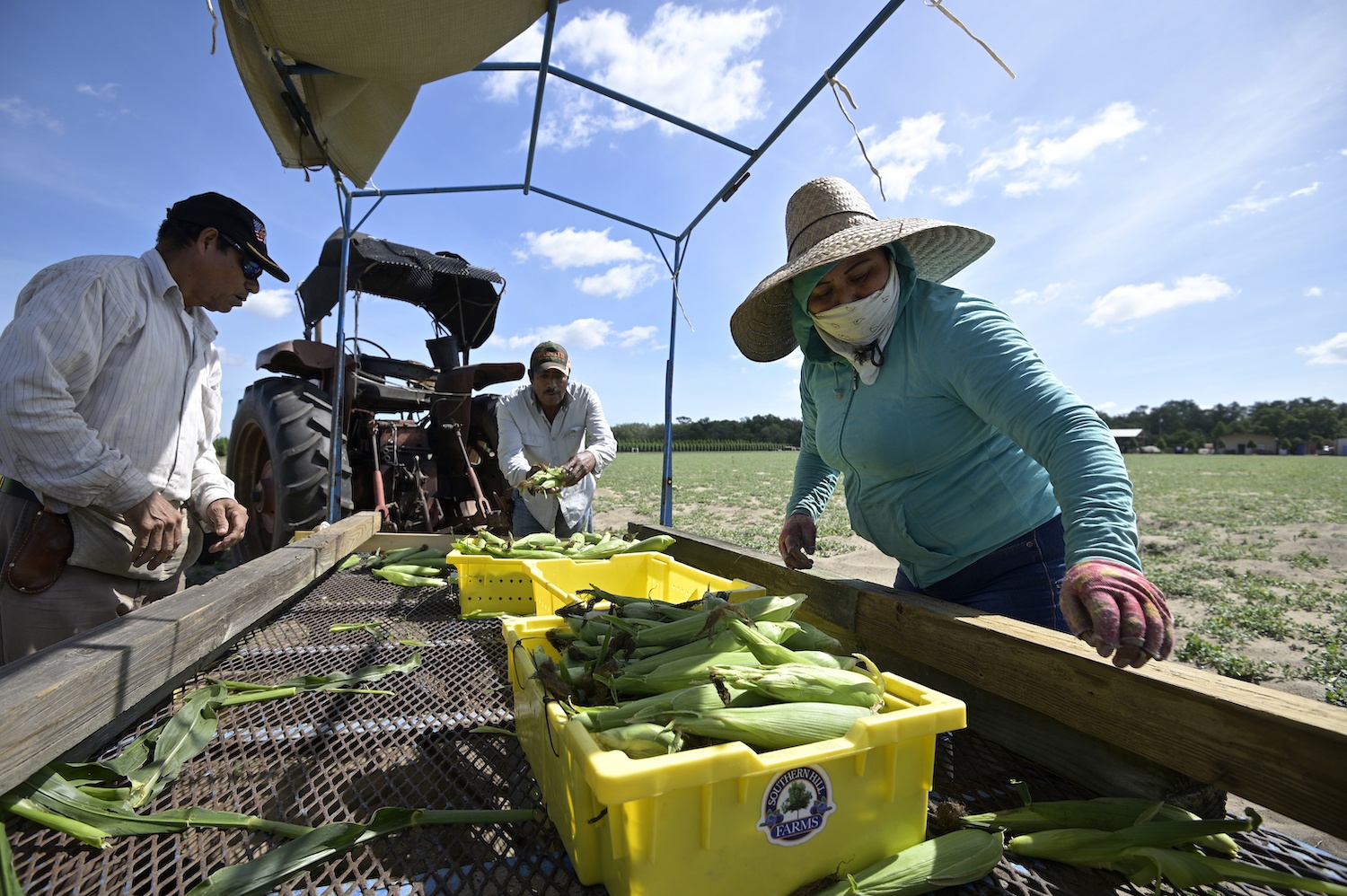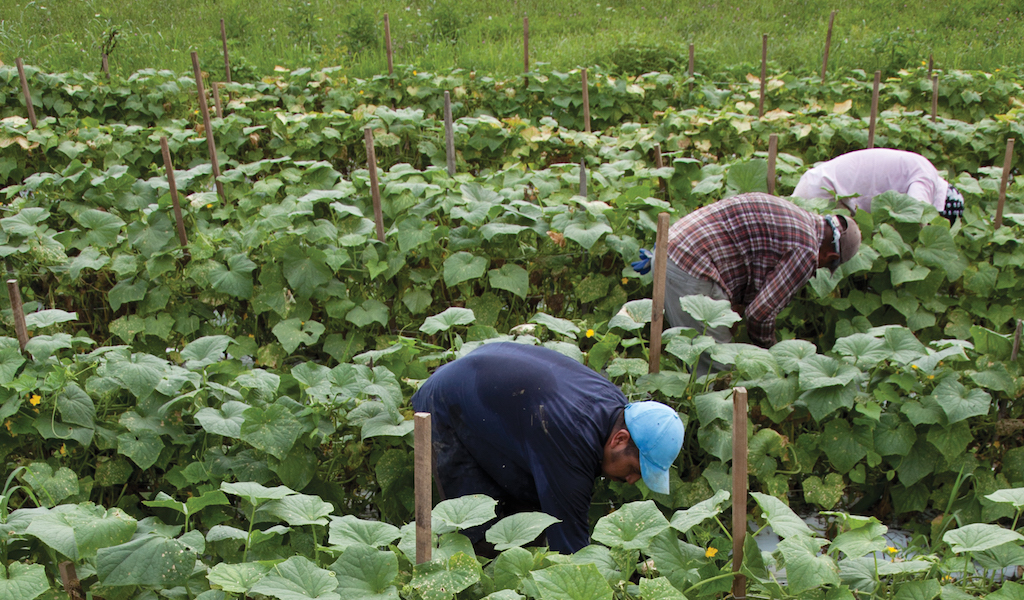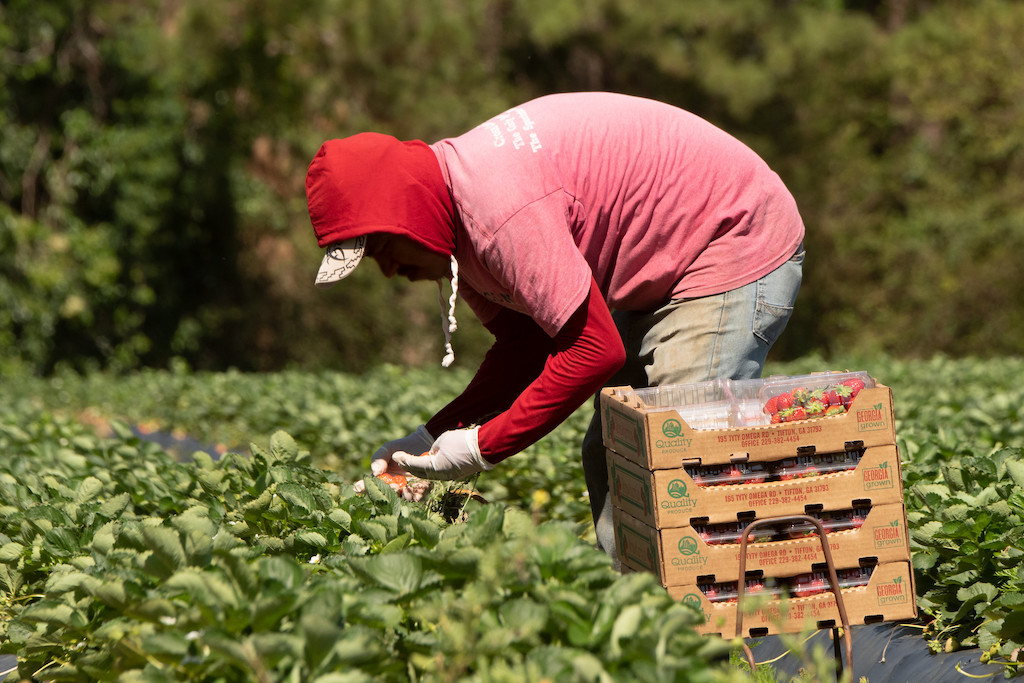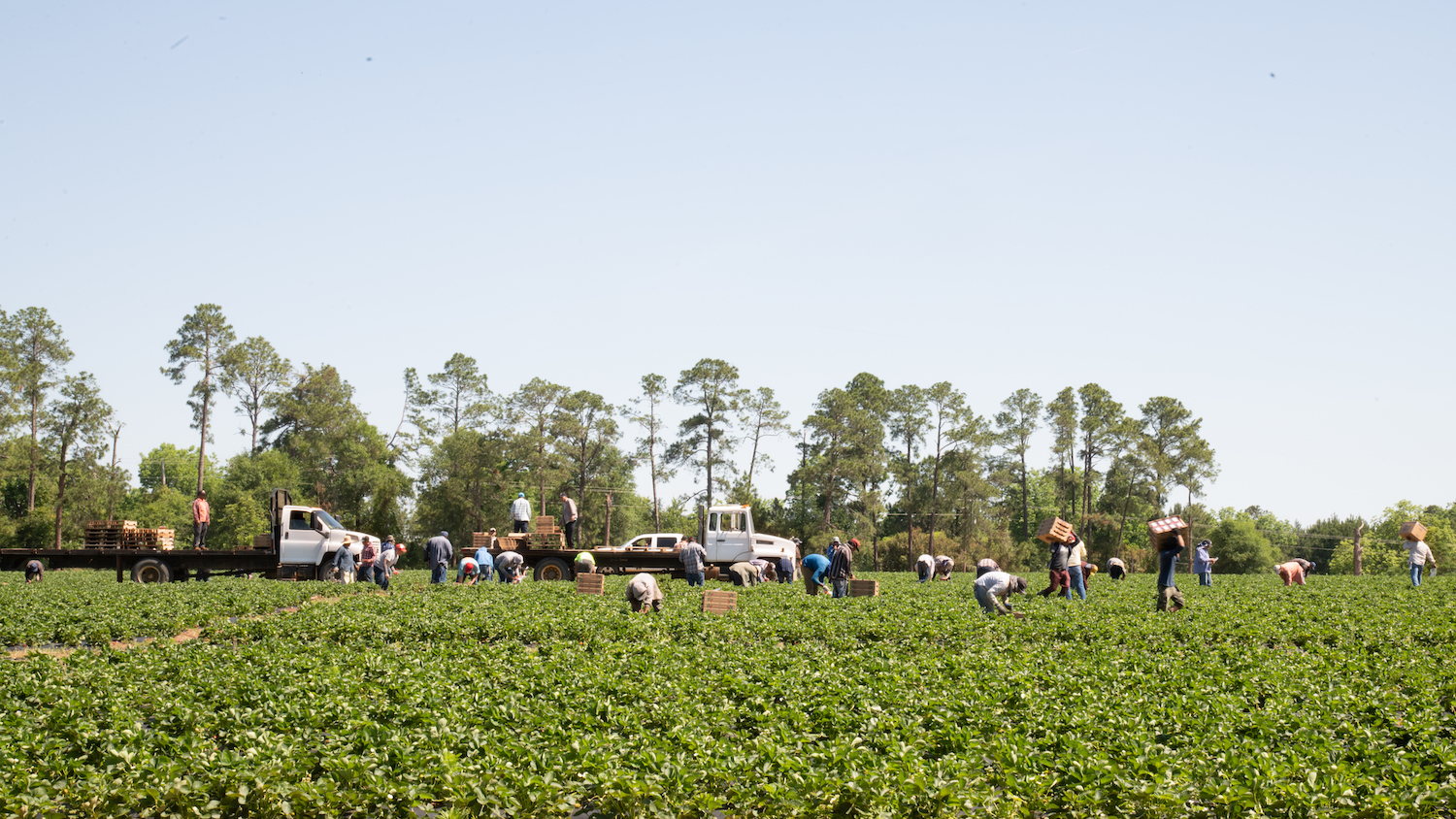
AP / Phelan M. Ebenhack
On average, crop workers are 20 times more likely to die from heat-related illness than any other worker. California and Washington have passed legislation to ensure basic safety measures are in place. Why have Florida’s legislators repeatedly failed to do the same?
Last June, one of the hottest in Florida’s history, farm worker Procopio Magaña fainted in the field where he had been picking tomatoes for more than six hours. When he passed out, staggering toward the shade, the temperature was 94 degrees. According to the medical examiner’s report, paramedics found him lying on his back on a picnic table. He was short of breath and moaning. His skin was hot and dry. Shortly after he arrived at the hospital, 43-year-old Magaña’s pulse weakened and he died. Official cause: “heatstroke due to environmental exposure.”
Tragic as it may be, what happened to Magaña could happen far more frequently in the coming years. According to a recent study from Stanford University and University of Washington researchers, published in April in Environmental Research Letters, by the end of this century, farm workers will suffer through, on average, three times as many unsafe working days every summer as they do now—days during which the heat index, which is temperature plus humidity, soars above 83 degrees.
Those predictions are concerning enough. But in Florida, America’s second-largest vegetable producing state, farm workers already endure around 100 of those days every year, which occupational health experts say is a dangerous level of exposure.
In a 2-degree-Celsius warmer world, which scientists predict will be our reality by 2050, crop workers will experience 39 days of unsafe heat on average.
Last year, according to public Occupational Health and Safety Administration (OSHA) databases, nine Florida farm workers suffered severe and fatal injuries caused by the heat. It’s a troubling number, but one that labor advocates say is probably just a sliver of the true total.
And while some other major agriculture producing states—California and Washington among them—have passed legislation intended to protect farm workers from the elevated risk posed by excessive heat combined with the physical intensity of their work, Florida legislators have repeatedly failed to do the same.
On average, crop workers are 20 times more likely to die from heat-related illness than any other worker, according to the Centers for Disease Control and Prevention (CDC). The reasons for that statistic aren’t just about what happens on the job: Most farm workers don’t have employee benefits like health insurance, which limits their access to treatment for heat injuries, or conditions that make them more vulnerable, like diabetes, cardiovascular disease, or viral infections. Others may live in dorms or motels without air conditioning, which is crucial for nighttime recovery, says Michelle Tigchelaar, the study’s lead author.
“A lot of people are very vulnerable, and required to put themselves at really high risk, to continue providing food at affordable rates for us consumers in grocery stores.”
Pay structure, too, plays a role. Many workers are paid a per-piece rate, or by the bucket, which can be an incentive to work quickly, for as long as they can, without lunch or breaks.
Heat is a silent killer. Employers and workers alike can have difficulty recognizing the warning signs of heat stress, and may not be trained on how to stop it from getting worse.
“A lot of people are very vulnerable, and required to put themselves at really high risk, to continue providing food at affordable rates for us consumers in grocery stores,” said Tigchelaar.
According to her study, the average crop worker, nationwide, currently labors through around 21 unsafe working days every growing season—days when the heat index approaches 84 degrees. In a 2-degree-Celsius warmer world, which scientists predict will be our reality by 2050, crop workers will experience 39 days of unsafe heat on average. By the end of the century, as air temperatures rise by four degrees globally, American crop workers will labor, on average, for 62 days in unsafe conditions.
Despite the apparent health risks a warming planet poses for Florida’s tens of thousands of farm workers, state legislators have shown little interest in passing new regulations that could save lives now.
But farm workers in Florida are particularly vulnerable. Take Manatee County, the region outside Bradenton where Magaña died. Field laborers there already suffer through 116 unsafe working days a year. By 2050, that number will rise to 139 days of dangerous heat, and then to 149 days of unsafe heat by the end of the century—five straight months of potentially fatal conditions.
Despite the apparent health risks a warming planet poses for Florida’s tens of thousands of farm workers, state legislators have shown little interest in passing new regulations that could save lives now.
State Senator Victor Torres is a former bus driver who, for three straight years, has unsuccessfully introduced heat illness prevention bills in the legislature. The bills failed in committees without a hearing or a vote.
“They can make all the excuses in the world. But we’re talking about human life.”
“They can say whatever they want,” Torres, a Democrat, said of the Senate leadership. “They can make all the excuses in the world. But we’re talking about human life.”
(Republican state senators Ben Albritton and Gayle Harrell, and Democrat Bill Montford, who chaired the committees, did not respond to requests for comment.)
Last November, Carlos Guillermo Smith, a state representative from Orlando, introduced a companion bill in the House. The heat illness prevention bill would have established safety standards for outdoor workers, akin to similar rules in California, and to suggestions already made by OSHA online.
Had it passed, the bill would have required employers to maintain cool, shady areas for workers when the heat index exceeds 80 degrees, and allow employees at least a 15-minute break if they showed signs of heat illness. At 90 degrees, all employees would get 10-minute breaks every two hours.
“The very conservative Florida legislature has been very averse to creating any new regulations or requirement on businesses.”
The bill would also have required employers to train supervisors and employees to recognize the signs and symptoms of heat illness—like heavy sweating, muscle spasms, headaches, nausea, and dizziness—and to use first-aid measures when needed. And it mandated that workers be educated on the importance of acclimatization, which is a gradual, two-week period of heat exposure, to get used to working conditions.
The bill contained no language about fines for violations. Still, Smith wasn’t able to turn the recommendations into official rules. In March, for the second straight year, his bill died in a workforce subcommittee without a vote.
Failure to land any meaningful legislation doesn’t appear to be because the Florida legislature isn’t interested in heat stress as an issue. In June, the state’s Republican Governor, Ron DeSantis, signed into law a House bill to prevent heat-related injuries in student athletes. The bill, which passed both chambers unanimously, requires guidelines for heat prevention, including when to make cool areas, ice baths and water available, based on outdoor heat index levels—provisions Smith wants to see made for people who work outdoors.
Industry representatives have previously said that heat stress regulations are not needed in Florida because employers already try to maintain safe workplaces.
“The very conservative Florida legislature has been very averse to creating any new regulations or requirement on businesses,” Smith said. “That’s just the honest answer.”
Like Torres’s bill, Smith’s bill has failed twice in committee without a hearing or vote. Rene Plasencia, the Republican chair of the workforce and tourism subcommittee, did not respond to requests for comment.
On one hand, it would seem the issue of extreme heat, and worker safety, is clear—at least to agencies specifically in charge of occupational health. The National Institute for Occupational Safety and Health, a division of CDC, has issued recommendations to employers for decades about how to protect workers who are exposed to heat during the work day, which were most recently updated in 2016.
The agency’s recommendations formed the basis of a petition to OSHA, filed by a coalition of labor groups and former federal workplace safety officials in 2018, to establish an official threshold for unsafe heat levels, akin to those that currently exist for air contaminants and pollutants. That heat-stress threshold would be based on the intensity of the work being performed, said David Arkush of Public Citizen, the progressive consumer rights advocacy group and think tank that led the petition.
“If a person goes on a bender, and is dehydrated, does it mean the employer’s at fault for their heat-related injury? It’s not that clean cut where to draw the line.”
OSHA never responded to the group’s petition. Last year, Representatives Judy Chu of California and Raul Grijalva of Arizona, both Democrats, introduced a bill that would have forced the agency to establish rules around paid rest breaks in the shade, access to water, and heat exposure limits, citing the urgent threat of ever-rising temperatures to outdoor workers. That bill did not advance past committee.
But, on the other hand, said Joseph Grzywacz, an occupational health expert at Florida State University who helps train farm workers to avert heat illness, some growers and farm operators believe they shouldn’t be responsible for a problem that they believe is personal and specific to individual biology. Air temperature and work intensity contribute to heat exhaustion, but they aren’t the sole causes, they argue.
“If a person goes on a bender, and is dehydrated, does it mean the employer’s at fault for their heat-related injury? It’s not that clean cut where to draw the line,” Grzywacz said.
Industry representatives have previously said that heat stress regulations are not needed in Florida because employers already try to maintain safe workplaces. After all, sick and injured workers aren’t good for productivity. Additionally, OSHA’s general duty clause, which requires employers to maintain safe workplaces “free from recognized hazards,” includes heat as one of those hazards.
“Farmers are clearly desiring an environment that keeps their workers safe, and OSHA directs them to do that,” said Adam Basford, a Florida Farm Bureau lobbyist.
Labor advocates say it’s not enough; general duty clauses are difficult to enforce. In the petition, Public Citizen noted that Cal/OSHA, California’s workplace safety agency, conducted 50 times more inspections resulting in a citation or violation for unsafe heat exposure practices than OSHA did nationwide during a four-year period.
“This alarming disparity clearly shows why a specific, enforceable heat standard is urgently needed on a federal level, rather than relying on the relatively ineffective” general duty clause, the petitioners wrote.
Torres, the Florida state senator, would agree. Undeterred by previous failures, he says he’s going to introduce his companion bill again in the next session.
“All I’m asking is that they understand this is not something to harm them,” he said. “This is something to protect and help those workers.”







